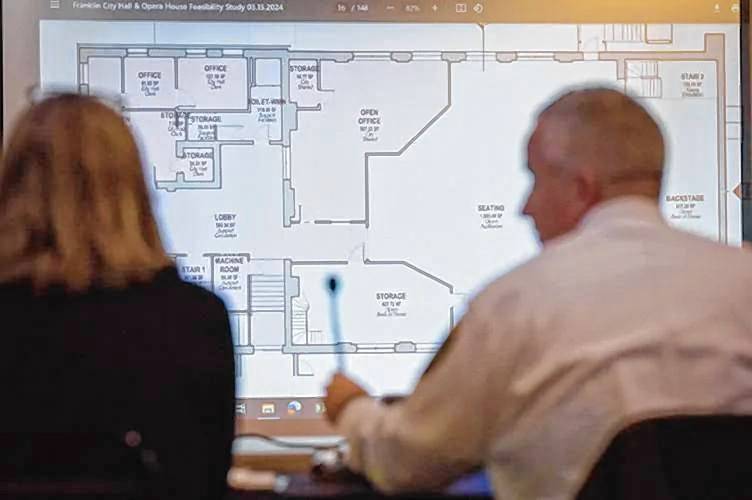Franklin Opera House renovations move forward after council approves concept plan

Principal architect Tracy Kozak of ARCove Architects, left, and Franklin Fire Chief Mike Foss review concept plans during a Franklin City Council meeting to discuss renovations to the Franklin Opera House and City Hall at Franklin Elks Lodge 1280 Monday night. DANIEL SARCH—Laconia Daily Sun staff photo
| Published: 11-20-2024 10:20 AM |
FRANKLIN — The city council voted unanimously to pass a conceptional design for renovations to Soldiers Memorial Hall, which houses the Franklin Opera House and city offices, after over an hour of discussion Monday night.
The meeting continued a discussion started at another session in October, where most of the conversation was focused on the Grand Army of the Republic Hall. Scheduled to start at 6 p.m., the public session was delayed an hour by a nonpublic session which started at 5 p.m. to discuss personnel matters. While there was no official confirmation of the topics or motions in the meeting, rumors made the rounds on Facebook, speculating the session could have been about appointing a new police chief. Chief David Goldstein retired last month.
New Hampshire’s Right-To-Know Law requires minutes and decisions reached in nonpublic session be publicly disclosed within 72 hours, unless there is a vote to withhold this information for a qualifying reason.
The public meeting started with discussion of GAR Hall renovations. In October, it was decided a second door would be added to the room to comply with safety codes, as the space could be used for meetings. Several councilors emphasized the necessity of leaving the hall as unchanged as possible. Councilor Ed Prive (Ward 3) was one such voice, and addressed principal architect Tracy Kozak of ARCove Architects directly.
“My concern was, as you’re trying to put that door in, you’re going to make sure that the integrity of this room stays intact, no damage, no nothing?” Prive said. “Is that a guarantee that you can give us, tonight, that the people that you hire is going to have the understanding that that’s a precious room, it’s hollowed ground, and that it can’t be damaged?”
Kozak hoped to reassure Prive of his concerns.
“The preservation of that room is of utmost importance and will be fully specified in the instructions to bidders, the design of it is to not change anything except add a door and fire sprinklers, which will be concealed.”
Another preservation concern brought up by councilors was replacing material within the building, including in GAR Hall. Kozak said this is a priority for her as well.
Article continues after...
Yesterday's Most Read Articles
 NH Supreme Court rules Concord resident lacks standing, clearing way for Andy Sanborn’s casino plans on Loudon Road
NH Supreme Court rules Concord resident lacks standing, clearing way for Andy Sanborn’s casino plans on Loudon Road
 Update: Two arrested in Concord spa raid for sex trafficking and prostitution
Update: Two arrested in Concord spa raid for sex trafficking and prostitution
 Arts Alley in downtown Concord marks its opening with first events Friday night
Arts Alley in downtown Concord marks its opening with first events Friday night
 New microschool opens in Bow to provide students with ‘different avenues’
New microschool opens in Bow to provide students with ‘different avenues’
 ‘A surprise and a disappointment’: As Executive Council stalls Caswell’s reappointment to BEA, lawmakers and business leaders have nothing but praise
‘A surprise and a disappointment’: As Executive Council stalls Caswell’s reappointment to BEA, lawmakers and business leaders have nothing but praise
 Man found deceased near Memorial Field identified as Concord 29-year-old
Man found deceased near Memorial Field identified as Concord 29-year-old
“We’re probably going to find lots of areas that need repair throughout the building,” she said. “And when it’s repaired in a significant area, it will be repaired in kind. We’d like materials to match the original.”
Kozak discussed potential options for scope reduction. When the budget for the project was approved in September, the council passed a resolution to spend $7.3 million, with the intent to reduce the total to $6.8 million through a $500,000 scope reduction.
Kozak presented five options to reduce cost. The first option was regarding a new transformer to support updated fire equipment. The concept plan also included a generator for the new smoke evacuation systems. Instead, less expensive smoke dampeners can be used. The building can also be fitted with less efficient boilers than planned, which only lowers current costs. The boilers would need to be replaced a few years from now and would be an expensive repair. Kozak also said she can simplify detail materials used for aesthetic purposes, find a simpler package for light fixtures and control systems.
Kozak did not know how much each of these options contribute to the total budget. The council must pass a concept plan before any bidding on items and materials can happen.
The discussion of the scope reduction brought on many questions regarding cost. There were concerns that passing this design concept would mean the council is voting for something beyond the $6.8 million agreed to. Ward 2 Councilor Olivia Zink jumped in to clarify.
“We’ve already authorized the $6.8[M]. So, Tracy knows that her next plan can’t be more than $6.8[M], so that’s what it will be,” Zink said. “We would love if it’s $6.6[M] or, if you can do anything that tells us any other cost saving options, we can do it in the next phase. But we’re not going to get that until the bid numbers go out, and we know how much the wood and materials are going for.”
Mayor Desiree McLaughlin said after the meeting she still had concerns with the project. She thought some councilors were still confused about different building phases, and wondered why, after councilors had already voted for a bond authorization note of $6.8 million.
“There are a number of things that I’m not comfortable with, that I am seeking advice,” McLaughlin said.
Despite the council receiving concept plans for the renovations, a meeting in September to approve the BAN was complicated by the inclusion of the scope reduction requirement, and Monday’s meeting intended to make the reduction ideas more concrete. Regardless, council must vote to approve the design separately, which would start the rest of the 14-month process. Kozak affirmed this is far from the last meeting during which the council will provide feedback and a vision for the historic building.
“We will also want some periodic feedback as we advance the design and get more refined systems and budgets,” she said. “We won’t just run and hide and then come back in a few months. We will have some design choices to offer. We want to make sure we’re on track with some of the key decisions as we go along.”







 Court docs: Concord spa under nearly decade-long scrutiny for suspected prostitution
Court docs: Concord spa under nearly decade-long scrutiny for suspected prostitution Allenstown weighs options for reintroducing trash pickup
Allenstown weighs options for reintroducing trash pickup Butterfly bench installation and pollinator event to honor memory of Concord woman
Butterfly bench installation and pollinator event to honor memory of Concord woman Summer camp offers support and adventure for children being raised by grandparents: ‘These kids got to be kids’
Summer camp offers support and adventure for children being raised by grandparents: ‘These kids got to be kids’
